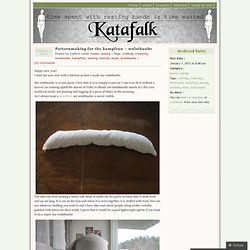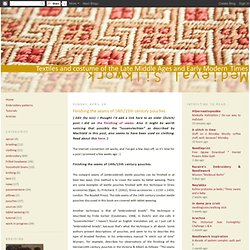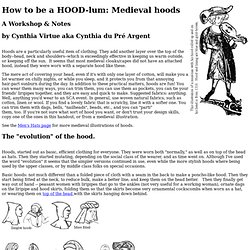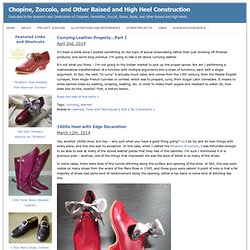

Patternmaking for the kampfrau – wulsthaube. Happy new year!

I start my new year with a tutorial on how I made my wulsthaube. My wulsthaube is in one piece, I love that it is so simple to put on, I can even do it without a mirror (or running uphill the streets of Visby to attend 100 landsknecht march as I did 2011 medieval week), not pinning and tugging at a piece of fabric in the morning.
As I always wear a steuchlein my wulsthaube is never visible. You start out with making a fabric roll. Mine is made out of a piece of linen that is 16cm wide and 44 cm long. Then I take a piece of fabric, I used a old linen panel curtain found thrift shopping. I pin it in the nape of my neck (I look kind of aggressive in this picture, angryfrau!) Put the fabric over your head. And add the wulst. I start with pinning it at the centre top. Then I pull the fabric taut over the wulsthaube pinning it as I go along. Now you are ready to start draping. Remember to put pins where you pinned it at the nape of your neck.
Put it on your trusty helper. Like this: Revival Leather Goods & Adkins Historical Reproductions - Home. Shoes & Pattens. Muzeum Dublin. Graceful ways to wear a veil. <map name="admap53533" id="admap53533"><area href=" shape="rect" coords="0,0,468,60" title="" alt="" target="_blank" /></map><table cellpadding="0" border="0" cellspacing="0" width="100%" bgcolor="#ffffff"><tr><td align="right"><img src=" width="468" height="60" usemap="#admap53533" border="0" alt="" /></td></tr><tr><td bgcolor="#ffffff" colspan="1"><center><a style="font-size:10px;color:#0000ff;text-decoration:none;line-height:1.2;font-weight:bold;font-family:Tahoma, verdana,arial,helvetica,sans-serif;text-transform: none;letter-spacing:normal;text-shadow:none;white-space:normal;word-spacing:normal;" href=" target="_blank">Ads by Project Wonderful!

Your ad here, right now: $0</a></center></td></tr><tr><td colspan="1" valign="top" width="468" bgcolor="#000000" style="height:3px;font-size:1px;padding:0px;max-height:3px;"></td></tr></table> by Cynthia du Pré Argent © 2000-2004 Cynthia Virtue The things you need are: A veil (I like smaller veils, maybe 1' in radius.) Let's get started. Archery Bracers, Combat VamBrace, and other Goodies. Patterns To Make The T-Tunic - All the resources to construct this garment: The Garb Index. I have an early period persona, and so my garb consists mainly of that universal 'newcomer's garb', the T-tunic.

But a T-tunic in period was far from simple. It was a complex garment made up of many pattern-pieces, a far cry from our one-piece, fold-and-sew standard material-waster. This article is the result of some research I've done, and an attempt to put that research into a practical application for the SCA folk who want to be a little more adventurous with that ubiquitous garment.Maggie ForestA very brief outline of how to make a non-authentic t-tunicClemence L'Estrangenon-authentic linkBill McConnellThis article shows you how to make a simple piece of medieval-ish clothing.Canton of Wolfsgate (an SCA group)This article claims to be a t-tunic pattern easy enough for a stick jock to make. Must be pretty easy then... Is your site listed here, but you don't want to continue hosting it?
Read more about The T-Tunic What is this? Medieval Clothing Pages: Articles by Cynthia Virtue. <map name="admap53533" id="admap53533"><area href=" shape="rect" coords="0,0,468,60" title="" alt="" target="_blank" /></map><table cellpadding="0" border="0" cellspacing="0" width="100%" bgcolor="#ffffff"><tr><td align="right"><img src=" width="468" height="60" usemap="#admap53533" border="0" alt="" /></td></tr><tr><td bgcolor="#ffffff" colspan="1"><center><a style="font-size:10px;color:#0000ff;text-decoration:none;line-height:1.2;font-weight:bold;font-family:Tahoma, verdana,arial,helvetica,sans-serif;text-transform: none;letter-spacing:normal;text-shadow:none;white-space:normal;word-spacing:normal;" href=" target="_blank">Ads by Project Wonderful!

Your ad here, right now: $0</a></center></td></tr><tr><td colspan="1" valign="top" width="468" bgcolor="#000000" style="height:3px;font-size:1px;padding:0px;max-height:3px;"></td></tr></table> All material is © 2000-2011 Cynthia Virtue. See below for copyright issues . Guest Articles hosted here for their authors Why these articles are here: Finishing the seams of 14th/15th century pouches. The internet connection stil works, and I've got a few days off, so it's time for a post I promised a few weeks ago :-)Finishing the seams of 14th/15th century pouches The outward seams of (embroidered) textile pouches can be finished in at least two ways.

One method is to cover the seams by tablet weaving. There are some examples of textile pouches finished with this technique in Dress accessories (Egan, G., Pritchard, F. (2002), Dress accessories. c.1150- c.1450, London: The Boydell Press). The side seams of the 14th century London textile pouches discussed in this book are covered with tablet weaving. Another technique is that of “embroidered braids”. It seems to have been quite common technique in the European mainland in the 14th and 15th century. The Netherlands , Maastricht St Servaas CathedralStaufer, A. (1991), Die mittelalterlichen Textilien von St. This is how I apply the technique: attach two loops of thread (A and B) to the inside of the pouch attach loop A cover all sides. Clothing, Costuming and Textiles - Ravensgard. Eneral Costuming mbroidery, Textiles and Dyes arp-Weighted Loom ablet Weaving ewelry Making eneral Supplies.

Hoodlum. <map name="admap53533" id="admap53533"><area href=" shape="rect" coords="0,0,468,60" title="" alt="" target="_blank" /></map><table cellpadding="0" border="0" cellspacing="0" width="100%" bgcolor="#ffffff"><tr><td align="right"><img src=" width="468" height="60" usemap="#admap53533" border="0" alt="" /></td></tr><tr><td bgcolor="#ffffff" colspan="1"><center><a style="font-size:10px;color:#0000ff;text-decoration:none;line-height:1.2;font-weight:bold;font-family:Tahoma, verdana,arial,helvetica,sans-serif;text-transform: none;letter-spacing:normal;text-shadow:none;white-space:normal;word-spacing:normal;" href=" target="_blank">Ads by Project Wonderful!

Your ad here, right now: $0</a></center></td></tr><tr><td colspan="1" valign="top" width="468" bgcolor="#000000" style="height:3px;font-size:1px;padding:0px;max-height:3px;"></td></tr></table> A Workshop & Notes by Cynthia Virtue aka Cynthia du Pré Argent Hoods are a particularly useful item of clothing.
Chopine, Zoccolo, and Other Raised Heel and High Heel Construction. Currying Leather Properly…Part I April 2nd, 2014 It’s been a while since I posted something on the topic of actual shoemaking rather than just showing off finished products, and we’re long overdue.

I’m going to talk a bit about currying leather. It’s not what you think – I’m not going to the Indian market to pick up the proper spices. Nor am I performing a mathematical transformation of a function with multiple arguments into a chain of functions, each with a single argument. Read the rest of this entry » 1600s Heel with Edge Decoration March 12th, 2014 Yes, another 1600s shoe, but hey – why quit when you have a good thing going? In some cases, there were lines of fine tunnel stitching along the surface and opening of the shoe. How about some background and construction shots: Read the rest of this entry » 1780s Shoes – Finished Products! March 6th, 2014.